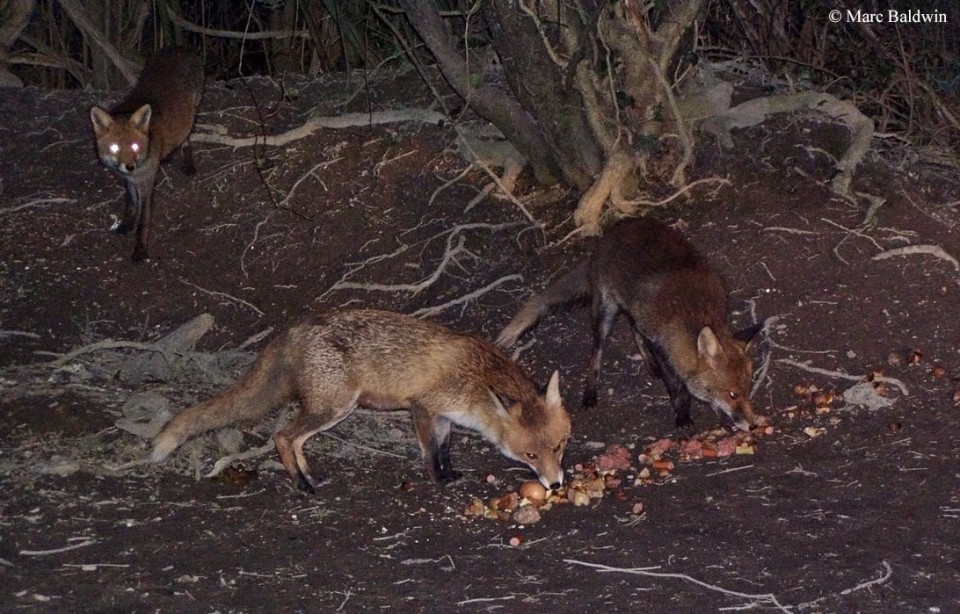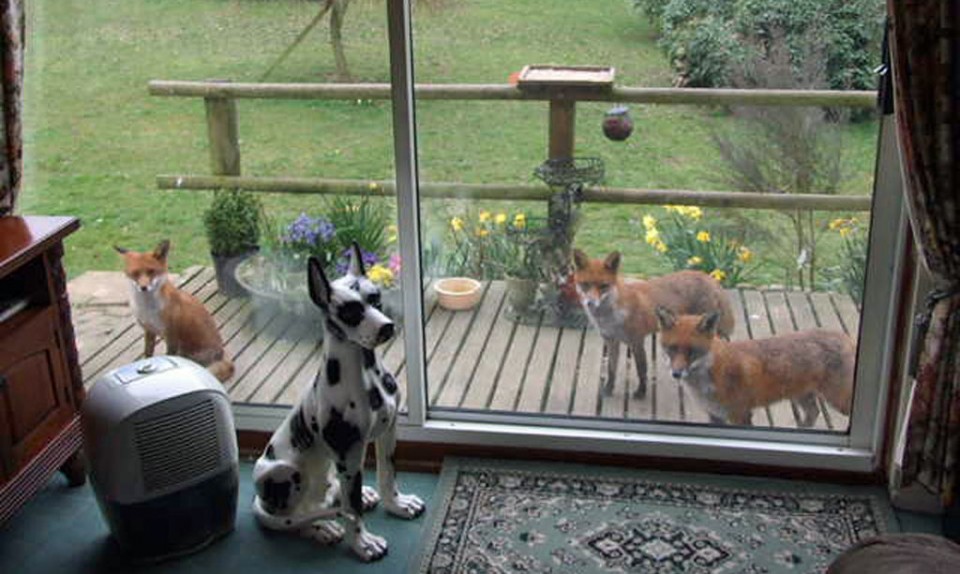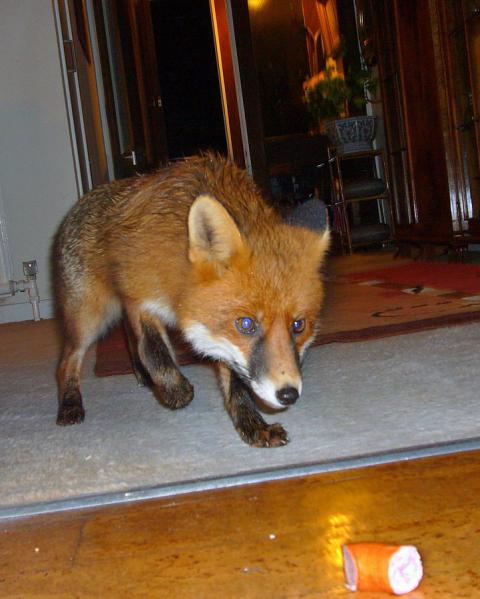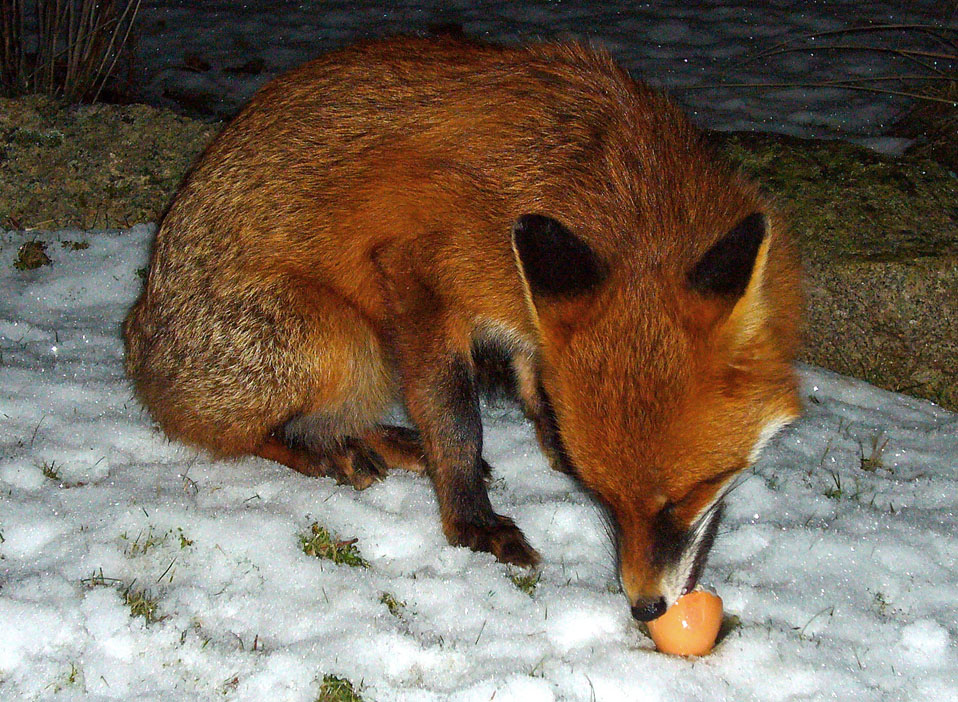Red Fox Interaction with Humans - Interacting with Wild Foxes
Not everyone has four thousand pounds to spend buying a domesticated farm fox and, as such, are restricted to watching wild animals. Getting even a glimpse of a wild rural fox can be frustratingly difficult (and I speak from considerable personal experience there); but, fortunately for those who appreciate being able to see these mammals, foxes have readily taken to our towns and cities and are now frequent visitors to gardens, whether we realise it or not.
Foxes began living in our cities after World War I; a response, many consider, to a change in people’s lifestyles. There has been some suggestion that an outbreak of myxomatosis in Britain during the early 1950s actuated the fox’s colonisation of urban areas, although the current evidence doesn’t support this theory (see urban fox QA). Indeed, it is widely held that the most likely "cause" of urban foxes was the development of once rural land after the First World War; land was built upon and, rather than moving, the foxes adapted to their new surroundings. Whatever the ultimate reason for foxes appearing in our towns, they have thrived in this environment and shortly after World War II they were commonplace in some southern cities. DEFRA, at the time known as MAFF, for example, shot 181 foxes in southeast London during 1947.
My experience, and that of many others, is that foxes readily become used to human activity and learn to ignore it. (It is worth mentioning that tolerance is not the same as “tameness”, which is a mistake many people seem to make – wild foxes are just that, wild, regardless of how relaxed they appear in your company.) In fact, they can become so unfazed by, almost complacent of, human activity that they have been seen in busy high streets during the daytime, they wander around an industrial estate near me in the middle of the day ignoring the cars and workers, and dodge lorries to scavenge on rubbish tips. It should be remembered that foxes have evolved a strategy of judging danger, in centuries past from predators such as wolves and lynx, from a distance, which probably explains why they tend to sit and watch us rather than immediately fleeing.

The most extreme example of "fox complacency" I have come across is a fox letting a child play with her cubs. In a short paper to the journal Ecologist on the spread of the fox in the London area, Ian Beames described how, in 1969, a family of fox cubs spent some time playing with a five-year-old girl and her ball in a Surrey garden, as the vixen sat quietly watching. Such behavioural plasticity (i.e. the ability to rapidly alter your behaviour to make the best of a situation) means that, with a little patience, foxes can be easy to watch. Often food is required, even if only initially, to win the fox’s trust and give it a reason to hang around in the area.
In some cases, the fox may become very familiar with the feeding regime. One fox I had the pleasure of watching in West Sussex, many years ago now, was known to wait under the same tree at a specified time every night for the owner of an adjacent house to supply her a supper of dog food. Apparently, on one occasion when the "waiter" was engaged for longer than anticipated and failed to meet the 9pm feeding, the fox crossed the road, went into his front garden, put its paws on the window ledge and peered into his lounge.
I have frequently heard it said that feeding foxes is a bad idea, usually based on two lines of reasoning:
1. Foxes will become dependent upon the food source and starve if said food is removed.
2. Foxes fed by humans are likely to readily lose any fear they have of people and may even approach strangers looking for food.

Personally, I don't believe that either of these arguments give foxes the credit they deserve. The Red fox is a terrifically adaptable species and, as we’ve already seen, have one of the most catholic diets of any mammal. There is a mountain of science supporting the tendency of foxes to switch their prey and no indication of reliance on any one prey source. Similarly, many wildlife rehabilitators have commented on how the foxes they have raised have readily accepted a free meal from them, but never shown any indication that they were reliant upon it. Indeed, the dependency argument is undermined when was look at the domestic cat; a species humans appear to have been actively domesticating for the last 9,000 years or so. That cats are raised from kittens, provisioned with all the food they need, does nothing to appreciably dampen their prey drive. If nothing else, the pet moggy teaches us that we cannot assume that the provision of food leads to dependency.
Along much the same lines, foxes are intelligent animals that can readily separate friend from foe. My own experience with these animals, coupled with stories from fox-keeping/rehabilitating friends and the literature offer no indication that one person feeding a fox makes that fox unafraid of all people. Michael Chambers provides several examples of how his hand-reared vixen ("Ferdi") would accompany him on walks with his dogs, but disappear whenever people appeared, only to reappear once they had gone. In Chapter 17 of his book Free Spirit, Chambers sums the situation succinctly:
"Ferdi trusted only me, retaining her instinctive suspicion of all other men, and so her association with me did not undermine her security ..."
The subject of feeding wildlife (and its associated pros and cons) is discussed in a separate Q/A, so I won't repeat it here. Sufficed to say that feeding wildlife comes with its risks, but many can be overcome by feeding responsibly. Overall, in my opinion, if you want to feed foxes in your garden, there are a few simple guidelines you should take into consideration:

1. Remember that not everyone shares your appreciation of foxes (or wildlife in general). Neighbours with small livestock housed outside (e.g. chickens, rabbits, guinea pigs, etc.) may be especially unimpressed by your fox-feeding activities. It is also worth bearing in mind that food taken from your garden may be buried in your neighbour's garden.
2. Do not feed highly processed foods (e.g. cakes, crisps and snacks) and especially not chocolate (see chocolate QA for a discussion of this). A "fast food" diet can result in health problems for the fox. I have heard stories of people buying cream cakes and chocolate gateaux for their foxes; these should be avoided.
3. Do not feed too much. You don't need to put out lots of food and are arguably better off just scattering some dog biscuits around the garden. Over-feeding can lead to changes in the distribution and activity of foxes, resulting in more foxes in a given area and/or concentration of disturbance (digging, faeces, etc.) in a smaller area.
4. Do spread the food around. This will increase the time the fox will spend in your garden as it collects all the food and reduces the potential for aggressive encounters if you have several foxes visiting at the same time.
5. Do feed them things they're likely to encounter while foraging naturally such as meat (raw or cooked), fruit and berries, vegetables, eggs, earthworms and so forth. Tinned dog food is also an option.
6. Do put out water, which is often more important to the fox (and many other garden mammals) than food.
7. Do not encourage the foxes to take food from your hand, or to come into your house for food.
My preferred method of watching foxes in a garden is to scatter a couple of handfuls of dog biscuits around the garden and sit inside the house (or, being an amateur photographer, in a hide/shed) to await the fox’s arrival. The scattering prolongs the fox’s visit and, by not being in the garden, there’s no risk of the fox associating me with the food.
As touched on elsewhere (see Behaviour - Evolution of Group Living), be aware that putting out food for foxes can lead to changes in territory size and fox density. In northwest Bristol, Stephen Harris and his colleagues observed a positive feedback loop with regards to householders putting out food for foxes and the number of fox sightings. The biologists found that as the number of people putting out food increased, more fox sightings were reported and more food was put out, leading to each given patch being able to support more and more foxes. At one stage (before mange arrived), Harris and his co-workers recorded 30 adult foxes per square kilometre – the highest density of foxes ever recorded. That said, it is important to remember is that, contrary to expectation, there's no correlation between the number of times foxes are seen and the actual number in the neighbourhood, nor the level of disturbance that can be expected.

Jo Dorning and Stephen Harris, in their 2017 paper to Behavioral Ecology, note that in their study area of northwest Bristol one garden feeding station situated near the boundary of three territories attracted 32 visiting foxes. They concluded:
“… our data confirm that human provisioning in urban areas attracts more foxes for longer …”
Ultimately, foxes are in our towns and cities to stay and we have two choices: we can learn to live with them; or we can opt for a never-ending all-out war on them in a (probably futile) bid to eradicate them.